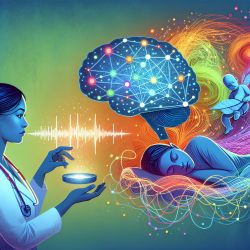Introduction
In the ever-evolving field of speech-language pathology, data-driven decisions are crucial for creating effective therapeutic outcomes. Recent advancements in neural network analysis of sleep stages have opened new avenues for diagnosing sleep disorders, particularly narcolepsy. This blog post delves into the findings of the research article "Neural network analysis of sleep stages enables efficient diagnosis of narcolepsy" and explores how practitioners can leverage these insights to enhance their diagnostic skills and potentially reduce the burden on sleep clinics.
The Power of Neural Networks in Sleep Stage Analysis
The traditional method of diagnosing sleep disorders such as Type-1 Narcolepsy (T1N) involves labor-intensive visual inspections of polysomnography (PSG) records by trained technicians. This process is not only time-consuming but also subjective and prone to inconsistencies. However, the introduction of neural networks in sleep stage analysis has revolutionized this process. By automating sleep stage scoring, neural networks produce a hypnodensity graph, which conveys more information than classical hypnograms.
Key Findings from the Research
The study utilized neural networks to analyze approximately 3,000 sleep recordings, both normal and abnormal, to automate sleep stage scoring. The accuracy of this automated scoring was validated against assessments by six scorers, with the best model outperforming any individual scorer with an accuracy of 87% versus the consensus. Moreover, the neural network could reliably score sleep down to 5-second intervals, compared to the traditional 30-second epochs.
One of the most significant outcomes of this research was the development of a T1N marker based on unusual sleep stage overlaps, achieving a specificity of 96% and a sensitivity of 91%. When combined with HLA-DQB1*06:02 typing, specificity increased to 99%. This method not only reduces the time spent in sleep clinics but also opens the possibility of diagnosing T1N using home sleep studies.
Implications for Practitioners
For practitioners, these findings suggest a shift towards more efficient and objective diagnostic processes for narcolepsy and potentially other sleep disorders. By integrating neural network analysis into their practice, practitioners can:
- Enhance diagnostic accuracy and consistency.
- Reduce the time and resources required for traditional sleep studies.
- Offer patients more accessible and less intrusive diagnostic options, such as home sleep studies.
Furthermore, practitioners are encouraged to stay abreast of developments in machine learning and neural networks to continuously improve their diagnostic capabilities.
Encouraging Further Research
While the study presents promising results, it also highlights the need for ongoing research to refine these neural network models and explore their applicability to other sleep disorders. Practitioners are encouraged to contribute to this body of research, either by participating in studies or by implementing these techniques in clinical settings and sharing their findings.
To read the original research paper, please follow this link: Neural network analysis of sleep stages enables efficient diagnosis of narcolepsy.










